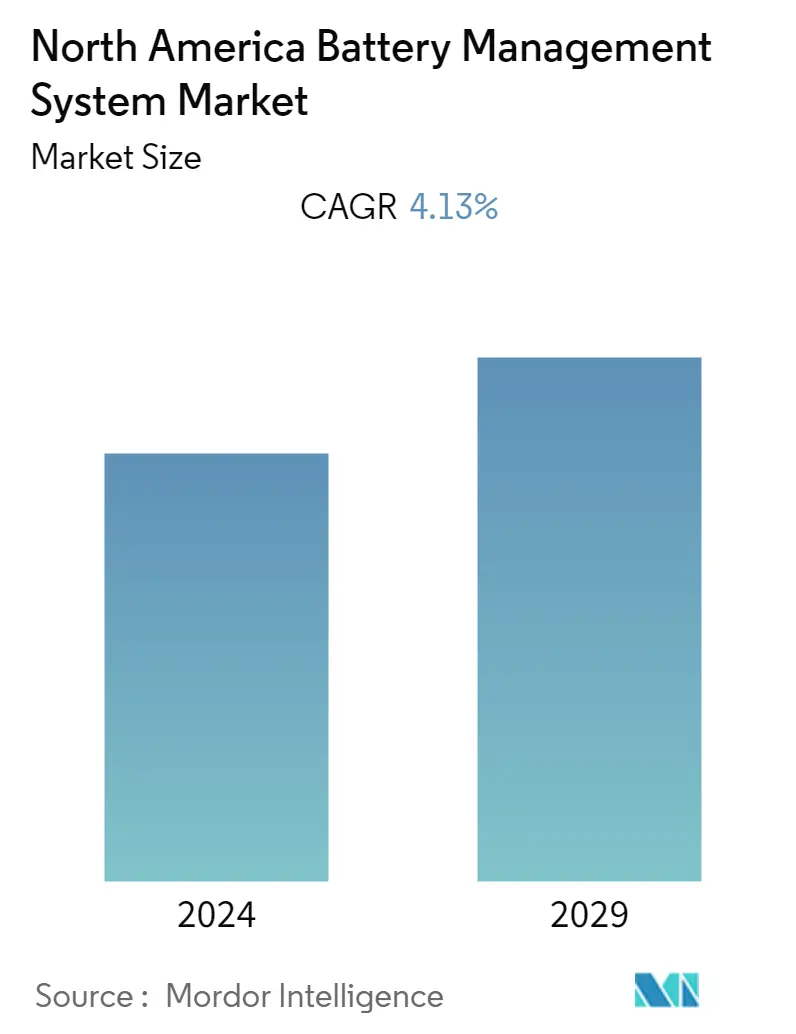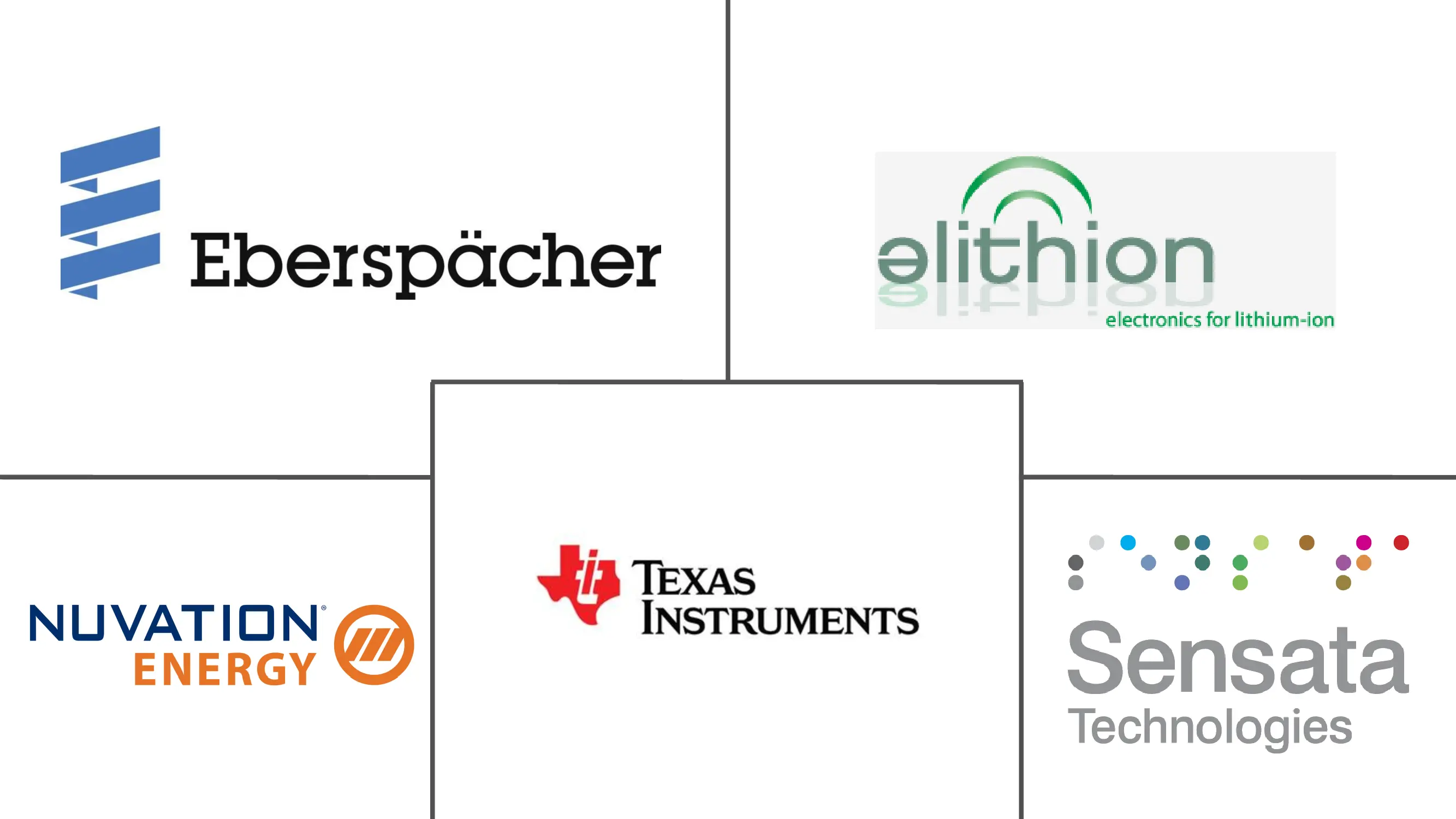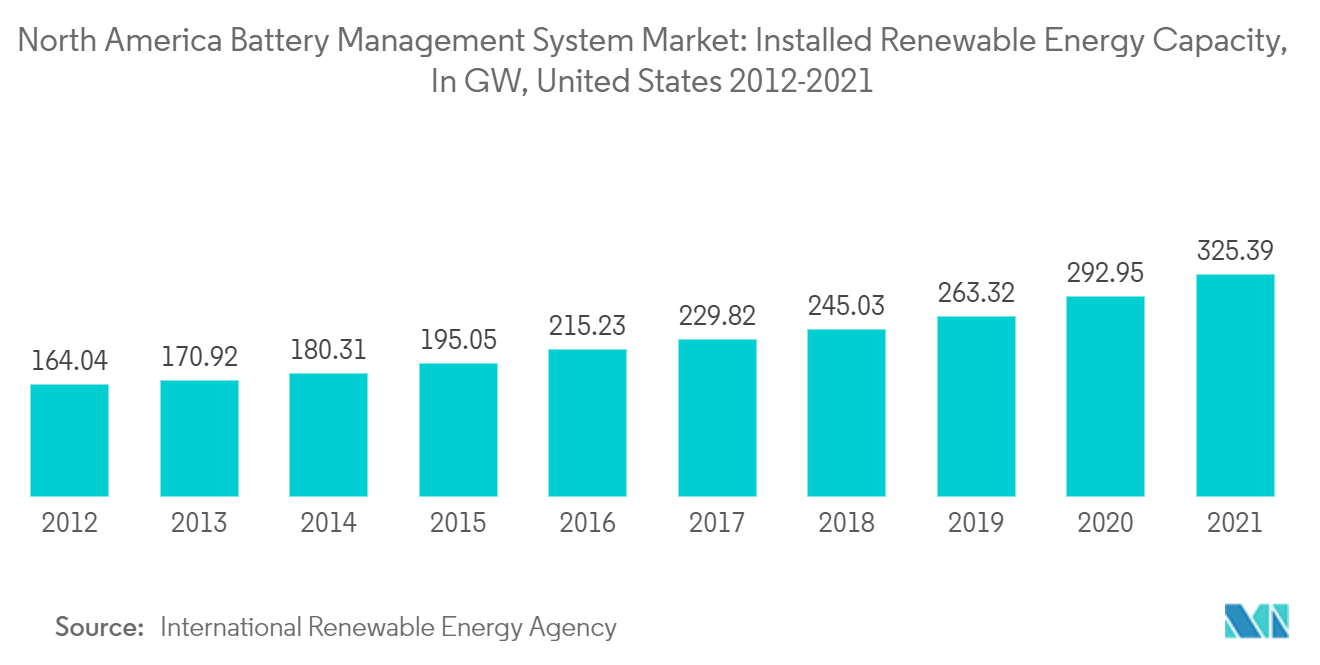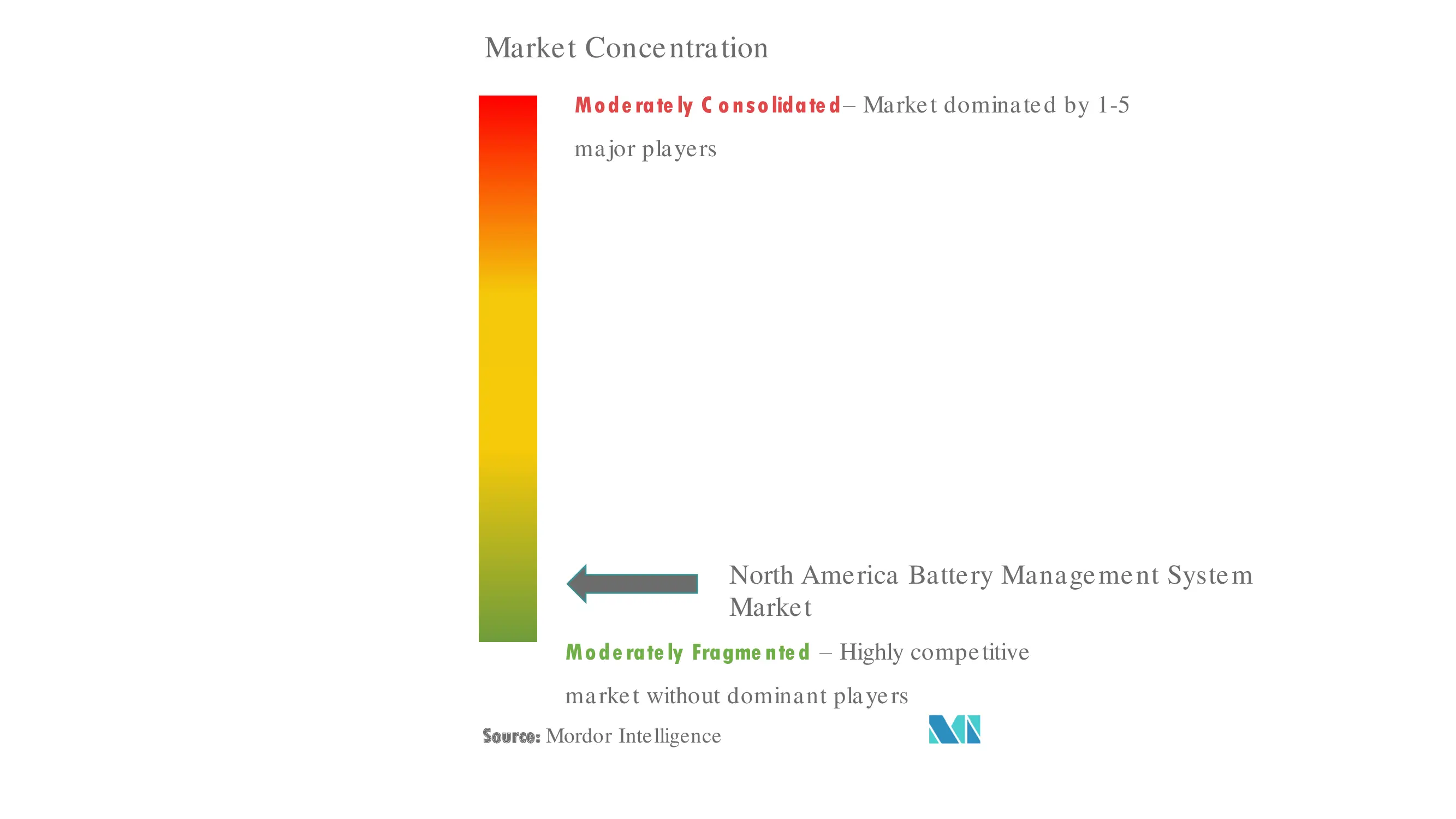North America Battery Management System Market Size

| Study Period | 2019 - 2029 |
| Base Year For Estimation | 2023 |
| Forecast Data Period | 2024 - 2029 |
| Historical Data Period | 2019 - 2022 |
| CAGR | 4.13 % |
| Market Concentration | Medium |
Major Players
*Disclaimer: Major Players sorted in no particular order |
North America Battery Management System Market Analysis
The North American battery management system is expected to reach USD 1.58 billion by the end of this year. It is projected to register a CAGR of over 4.13% during the forecast period.
The market was negatively impacted by COVID-19 in 2020. Presently the market has reached pre-pandemic levels.
- Over the medium term, the increasing safety concerns of lithium-ion batteries in ESS and EV applications are expected to drive the demand for an innovative and efficient battery management system (BMS) during the forecast period.
- On the other hand, the limitations in the off-the-shelf battery management systems are expected to make the current design outdated and impact the market studied during the forecast period.
- Nevertheless, technological advancements in battery management systems with advantages, such as reduced complexity, better efficiency, and improved reliability, are expected to provide growth opportunities in the future.
- The United States is expected to dominate the market during the forecast period due to the demand from two markets, i.e., energy storage systems and electric vehicles.
North America Battery Management System Market Trends
This section covers the major market trends shaping the North America Battery Management System Market according to our research experts:
Transportation Segment Expected to Dominate the Market
- Vehicles with internal combustion engines (ICE) were the only types used earlier. However, technology has been shifting toward electric vehicles (EVs) due to growing environmental concerns. Therefore, due to these reasons, battery management systems do not have any market in the ICE sector.
- Lithium-ion batteries are primarily used in EVs as they provide high energy density, low self-discharge, less weight, and low maintenance. For ICE vehicles, the lead-based battery is being widely used and is expected to continue to be the only viable mass-market battery system for the foreseeable future. For use in SLI applications, lithium-ion batteries still require higher cost reductions for them to be considered a viable mass-market alternative to lead-based batteries.
- Lithium-ion battery systems propel plug-in hybrid and electric vehicles. Owing to their high energy density, fast recharge capability, and high discharge power, lithium-ion batteries are the only available technology capable of meeting OEM requirements for the vehicles driving range and charging time. The lead-based traction batteries are not competitive for use in full hybrid electric vehicles or electric vehicles because of their lower specific energy and higher weight.
- Mexico is witnessing rapid growth in its EV manufacturing market. In April 2022, construction started on an EV parts manufacturing facility in Ramos Arizpe in the state of Coahuila. The factory is jointly owned by LG Electronics and Canadian automotive supplier Magna International and is expected to produce motors, inverters, and other EV components.
- In addition, in April 2022, Link EV announced plans to invest nearly USD 265 million in a new EV production facility in Puebla. The company plans to start operations in H2 2022, and the plant is expected to consist of four production lines with a nominal capacity of 1,200 units initially. Such large-scale developments in the production of EVs are expected to create a demand for EV BMS in the country during the forecast period.
- Similar to the United States, the Canadian automobile industry is also undergoing a transition, with most auto producers pivoting their business toward electrification by setting up new plants or repurposing older plants to produce EVs.
- For instance, General Motors has invested nearly USD 1.5 billion at its Oshawa and CAMI assembly plants and plans to launch the country's first full-scale commercial electric vehicle production facility at the CAMI Assembly Plant in Ingersoll. In April 2022, the government of Canada announced an investment of nearly USD 205 million in GM motors to assist in the construction of these plants. The CAMI plant is expected to begin commercial operation by the end of 2022.
- According to the Energy Information Agency (EIA), as of 2021, Canada's EV stock was recorded at approximately 306.61 thousand units, up by nearly 44,38% from 2020 stock volumes.
- Hence, based on the factors mentioned above, the transportation segment is likely to dominate the battery management systems market during the forecast period.

United States is Expected to Dominate the Market
- The United States will be one of the largest global markets for energy storage systems and electric vehicles in 2021. Both the end-user segments utilize battery management systems (BMS) for the adequate performance of the battery system. Due to the high demand from these two massive end-user industries, the country is expected to be one of the forecast period's most prominent and fastest-growing markets for BMS systems.
- The United States has one of the world's most well-developed automotive sectors. As climate and environmental concerns are rising, most automakers in the country have prioritized the production of electric vehicles. Additionally, the United States government has focused on increasing its electric vehicle fleet to reduce fossil fuel dependence and emissions.
- According to the Energy Information Agency (EIA), as of 2021, United States' EV stock was approximately 2.06 million, up by nearly 16.1% from 2020 stock volumes, making it the second largest global EV market after China.
- As of 2021, the United States is one of the largest renewable energy markets globally, and over the period of 2012-2021, installed renewable energy capacity has grown from nearly 164.04 GW to 325.39 GW, a growth of almost 74%. According to the United States Energy Information Administration (EIA), it is expected that renewable generation share to increase from 20% in 2021 to 22% in 2022 and 24% in 2023. According to EIA forecasts, 7.6 GW of new wind capacity is expected to come online in 2022 and 4.3 GW in 2023, while for utility-solar, new capacity additions of 21.8 GW for 2022 and 24.1 GW for 2023 are expected, and small-scale solar is expected to grow by 4.4 GW per year in both 2022 and 2023.
- Due to this rapid rise in renewable generation, grid stability has become a major issue in countries with a high level of renewable integration in their grids. Nearly 66% of the United States' installed renewable energy capacity is from wind and solar, which are inherently variable energy sources. To store renewable energy generation during high generation periods and release it during peak demand, ESS systems are needed, while BMs dictate the efficiency and operation of these systems.
- The United States is expected to witness the development of massive battery farms, which are expected to provide utility-scale energy storage. These utility-scale systems are to be monitored and operated via sophisticated BMS, which is expected to allow bi-directional energy flow and battery optimization to improve battery life while maximizing efficiency and minimizing accidents.
- In June 2022, the NADBank (North American Development Bank) announced that it plans to provide a USD 5.7 million loan for the Zier Solar and Energy Storage Project near the town of Brackettville in Kinney County, Texas. The 160 MW solar PV project is co-located with an 80MWh battery energy storage system (BESS). Construction is expected to start in 2022, while the project is expected to be commissioned by Q3 2023.
- Therefore, the above-stated factors can be considered the major driving factors for battery management systems in the country, where the market is expected to grow during the forecast period.

North America Battery Management System Industry Overview
The North American battery management system market is moderately fragmented. Some of the major players in the market (in no particular order) include Eberspaecher Vecture Inc., Elithion Inc., Texas Instruments Incorporated, Nuvation Energy, and Sensata Technologies Inc., among other companies.
North America Battery Management System Market Leaders
-
Eberspaecher Vecture Inc.
-
Elithion Inc.
-
Texas Instruments Incorporated
-
Nuvation Energy
-
Sensata Technologies Inc.
*Disclaimer: Major Players sorted in no particular order

North America Battery Management System Market News
- September 2022: A subsidiary of Canadian Solar, CSI Energy Storage, has launched the SolBank utility-scale battery product and announced a 10 GWh battery production capacity. SolBank is a proprietary battery solution designed and manufactured for utility-scale energy storage. In addition to liquid cooling and humidity control, the SolBank features active balancing BMSs (Battery Management Systems) that comply with international safety and compliance requirements.
- May 2022: A leading global vehicle manufacturer selected BorgWarner's battery management system (BMS) to fit its entire B-segment, C-segment, and light commercial vehicle platforms. Starting mid-2023, the new BorgWarner BMS technology is expected to optimize battery pack performance, safety, and longevity. BorgWarner's battery management system for hybrid and electric vehicles contains a master control unit connected to multiple cell management control units. It is designed to monitor the state of charge, health, and battery temperature of each battery cell and also precisely measure battery pack current and voltage.
North America Battery Management System Market Report - Table of Contents
1. INTRODUCTION
- 1.1 Scope of the Study
- 1.2 Market Definition
- 1.3 Study Assumptions
2. EXECUTIVE SUMMARY
3. RESEARCH METHODOLOGY
4. MARKET OVERVIEW
- 4.1 Introduction
- 4.2 Market Size and Demand Forecast in USD billion, till 2027
- 4.3 Recent Trends and Developments
- 4.4 Government Policies and Regulations
-
4.5 Market Dynamics
- 4.5.1 Drivers
- 4.5.2 Restraints
- 4.6 Supply Chain Analysis
-
4.7 Porter's Five Forces Analysis
- 4.7.1 Bargaining Power of Suppliers
- 4.7.2 Bargaining Power of Consumers
- 4.7.3 Threat of New Entrants
- 4.7.4 Threat of Substitutes Products and Services
- 4.7.5 Intensity of Competitive Rivalry
5. MARKET SEGMENTATION
-
5.1 Application
- 5.1.1 Stationary
- 5.1.2 Portable
- 5.1.3 Transportation
-
5.2 Geography
- 5.2.1 United States
- 5.2.2 Canada
- 5.2.3 Mexico
6. COMPETITIVE LANDSCAPE
- 6.1 Mergers and Acquisitions, Joint Ventures, Collaborations, and Agreements
- 6.2 Strategies Adopted by Leading Players
-
6.3 Company Profiles
- 6.3.1 Eberspaecher Vecture Inc.
- 6.3.2 Elithion Inc.
- 6.3.3 Texas Instruments Incorporated
- 6.3.4 Nuvation Energy
- 6.3.5 Sensata Technologies Inc.
- 6.3.6 BorgWarner Inc.
- 6.3.7 Romeo Power Inc.
- 6.3.8 ION Energy
- 6.3.9 Ewert Energy Systems Inc.
- 6.3.10 Schneider Electric SE
- *List Not Exhaustive
7. MARKET OPPORTUNITIES AND FUTURE TRENDS
** Subject To AvailablityNorth America Battery Management System Industry Segmentation
A battery management system (BMS) is described as an electronic system that controls and monitors the charging and discharging of batteries and provides notifications about the status and condition of battery packs. In addition, providing critical safeguards to protect batteries from damage is one of the primary functions of the battery management system.
The North American battery management system market is segmented by application and geography. By application, the market is segmented into stationary, portable, and transportation. The report also covers the market size and forecasts for the battery management system market across major countries. For each segment, the market sizing and forecasts have been done based on revenue (USD billion).
| Application | Stationary |
| Portable | |
| Transportation | |
| Geography | United States |
| Canada | |
| Mexico |
North America Battery Management System Market Research FAQs
What is the current North America Battery Management System Market size?
The North America Battery Management System Market is projected to register a CAGR of 4.13% during the forecast period (2024-2029)
Who are the key players in North America Battery Management System Market?
Eberspaecher Vecture Inc., Elithion Inc., Texas Instruments Incorporated, Nuvation Energy and Sensata Technologies Inc. are the major companies operating in the North America Battery Management System Market.
What years does this North America Battery Management System Market cover?
The report covers the North America Battery Management System Market historical market size for years: 2019, 2020, 2021, 2022 and 2023. The report also forecasts the North America Battery Management System Market size for years: 2024, 2025, 2026, 2027, 2028 and 2029.
North America Battery Management System Industry Report
Statistics for the 2024 North America Battery Management System market share, size and revenue growth rate, created by Mordor Intelligence™ Industry Reports. North America Battery Management System analysis includes a market forecast outlook to 2029 and historical overview. Get a sample of this industry analysis as a free report PDF download.



